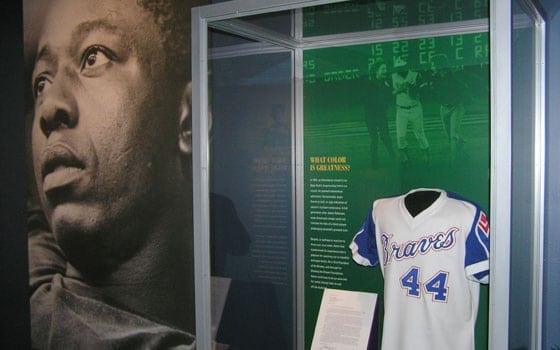

Author: Frederick Ellis Dashiell Jr.Hank Aaron became one of the most notable figures in baseball by breaking Babe Ruth’s home run record. The Museum of Science exhibit “Baseball as America” highlights this and discusses the opposition Aaron faced as a black baseball player.
As the summer wears on and baseball once again dominates this city’s thoughts, an exhibit at Boston’s Museum of Science is examining the sport’s central role in American history and society — a role defined, at least in part, by its complicated relationship with race.
“Baseball as America” began its Boston stay last month, and is slated to run through Sept. 1. Organized by the National Baseball Hall of Fame and Museum in Cooperstown, N.Y., the exhibit has traveled on a cross-country tour that kicked off six years ago with a grand opening at the American Museum of Natural History in New York.
Subsequent stops have included Chicago, Cincinnati, Cleveland, Dallas, Detroit, Houston, Los Angeles, Oakland, Calif., Philadelphia, St. Louis, St. Paul, Minn., St. Petersburg, Fla., and Washington, D.C.
The exhibit features more than 500 artifacts highlighting baseball’s influence on American culture, “everything from racial issues to baseball becoming a business,” according to Museum of Science spokesman Mike Morrison.
“The exhibit uses baseball as a mirror to society,” he said.
The expansive exhibit includes a look at the contributions of black and other minority players. The reflection goes beyond Jackie Robinson’s breaking the color barrier, or the well-known achievements of legends like former home run king Hank Aaron.
It also celebrates less popularized milestones, such as Frank Robinson becoming the first black manager in the majors when he took charge of the Cleveland Indians in 1975, and Emmett Ashford’s status as Major League Baseball’s first black umpire, working in the American League in the late 1960s.
The exhibit features posters from the Negro National League, showcasing teams like the Homestead Grays, and talks about the role baseball has played in providing blacks and other minorities with opportunities that they may otherwise not have had.
Lest its organizers be criticized for not telling the whole story, however, “Baseball as America” does openly discuss the sport’s troubled history.
The exhibit discusses the color line, sometimes referred to as the “Gentlemen’s Agreement,” an unwritten rule stretching back to the 1860s that banned all black and minority players from professional teams before Robinson signed with the Brooklyn Dodgers in 1945. It also includes a variety of negative promotional images from years past used to publicize the game and exclude minorities.
These images run the gamut from artists’ depictions of baseball players as clumsy pickaninnies to the cover of the 1906 song sheet “Brother Noah Gave Out Checks For Rain,” which features pictures of ballplayers in blackface.
Museum spokesman Morrison admitted he was concerned at first that “Baseball as America” would showcase positive images of the sport while eschewing any negativity concerning race. After reviewing its contents, however, he said he feels that the exhibit provides a balance representation of how minorities were treated throughout the years.
“[The exhibit] lets people come to their own conclusions about baseball and society and how the two are intertwined,” he said.
Attendees of the exhibit felt the same way.
“I like that the exhibit had the courage to highlight some of the negative aspects of how black players were treated,” said Sarah Patrick of Milton. “It is a good, honest look.”
“Baseball as America” runs through Sept. 1 at the Museum of Science, Boston, located at 1 Science Park in Boston. Ticket prices are $19 for adults, $16 for children ages 3-11, and $17 for seniors 60 and over. For more information, visit www.mos.org.






